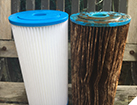Water
Water use, sustainability, and efficiency by choosing quality systems and materials, and providing environmentally friendly solutions.
Maintenance and repairs
Maintenance is crucial to keep the rainwater collection system in good condition and the water clean.
Research has shown that few owners maintain their rainwater tanks properly. Owners should have a maintenance schedule and a detailed understanding of what they need to do. They should follow the manufacturers’ maintenance recommendations for the tank and filters.
Maintenance schedule
- Depending on the situation, owners should clear the roof gutters, clean the leaf guards and first flush diverters every three to six months.
- As necessary, wash down roof surfaces with an environmentally-friendly detergent. Disconnect the pipe taking water to the tank first and rinse all surfaces thoroughly with clean water before reconnecting.
- Moss and mould growth can be removed by chemical cleaning with a solution of 1 part of household bleach to 4 parts of water. Proprietary cleaning products are also available. Disconnect the pipe taking water to the tank first and rinse all surfaces thoroughly with clean water before reconnecting.
- Any trees close to the collection area should be trimmed back and branches kept well clear of the roof and gutters.
- Tanks should be inspected at periods specified by the manufacturer. Sludge may be removed by siphoning or pumping without having to empty the entire tank.
- Check filtration and treatment systems as recommended by the manufacturers. This will require replacement of elements such as filters at specified intervals.
Roof maintenance
Replacement or repairs to a roof supplying a water storage tank must take account of the need to maintain the quality of the collected water, particularly for potable supply. The roof cladding, flashings and any applied coatings should be checked for suitability. After replacement, repair or recoating of a roof, water should be diverted away from the tank for at least one good rainfall period.
Replacement or repair of old gutters and downpipes provides the opportunity to:
- ensure gutters have adequate falls to allow for self-cleaning by rainfall
- add downpipe leaf guards or strainers, debris diverters, screened rainheads and first-flush diverters. Some suppliers of proprietary systems offer an installation service. If installation requires scaffolding, this may be a good path to follow.
Repairs and upgrades
Where repairs or upgrades to a system are considered, owners should be aware of who can legally carry out different tasks. For example, there are certain tasks that only a registered plumber can carry out:
- Work on piping of stored rainwater into a house that is also connected to the mains water supply.
- Work on piping of stored rainwater to a toilet cistern.
- Installing backflow prevention devices to prevent the unplanned reversal of flow of tank water into the mains water supply system.
- The installation of certain types of filtration systems.
Checking the tank
Water storage tanks should be checked every 6–12 months.
Once sediment build-up in the bottom of the tank has reached a depth of 250 mm or is thick enough to be drawn into a low-level fixed outlet or draw-off point, the tank should be desludged.
Where this requires emptying the tank, the general procedure is:
- drain the tank, using a pump if the tank can’t be completely emptied by gravity
- scrub to remove accumulated sediments and debris
- clean down all surfaces with chlorine solution and leave for at least 6 hours
- flush the tank to remove all traces of chlorine solution
- before disposing of the solution, neutralise the chlorine waste with sodium thiosulphate. Prevent the waste solution from entering stormwater systems and waterways – empty the discharge to lawn or open ground.
There are specialist tank cleaning companies who provide this service and many owners will find it convenient to use their services.
Refitting or replacing a tank
Where existing rainwater tanks do not already have them, devices that help ensure clean water may be able to be retrofitted. These include:
- a calmed inlet for rainwater entering the storage tank to minimise disturbance of sediment in the anaerobic zone at the bottom of the tank
- a floating valve outlet kit that directs the cleanest water from just below the surface to the tank outlet. A floating valve outlet must always be fitted in conjunction with a calmed inlet pipe
- a siphonic flush or vacuum system that automatically removes sediment and micro-organisms by siphoning water from the bottom of the tank each time the tank overflows.
Where a tank is leaking or in poor condition (corrosion of metal or weeping cracks in concrete) the tank should be replaced. Tanks specifically designed for urban use are often taller and occupy less ground area. Some tanks are designed to go above ground, while others may be able to be installed partially underground.
In many cases replacing a water tank will not require building consent. Whether or not consent is required depends on the size of the tank and how high above the ground it will be. For example, a tank of up to 35,000 litres supported directly by ground does not need building consent. You can find more details in the MBIE publication Building work that does not require a building consent.
Tanks should comply with AS/NZS 4020:2018 Testing of products for use in contact with drinking water and AS 2070:1999 Plastics materials for food contact use.
Whatever the task being carried out, take care with safety. If working on a roof or inside a storage tank, tell someone what you are doing and agree to check back with them when the job is done.
If user illness prompts repair work on a rainwater harvesting system, water can be made safe to drink by boiling as a temporary measure until repair work is completed.
An alternative temporary measure is to disinfect the tank water with sodium hypochlorite or hydrogen peroxide-based products, which are readily available from most hardware stores.
Updated: 13 October 2020


